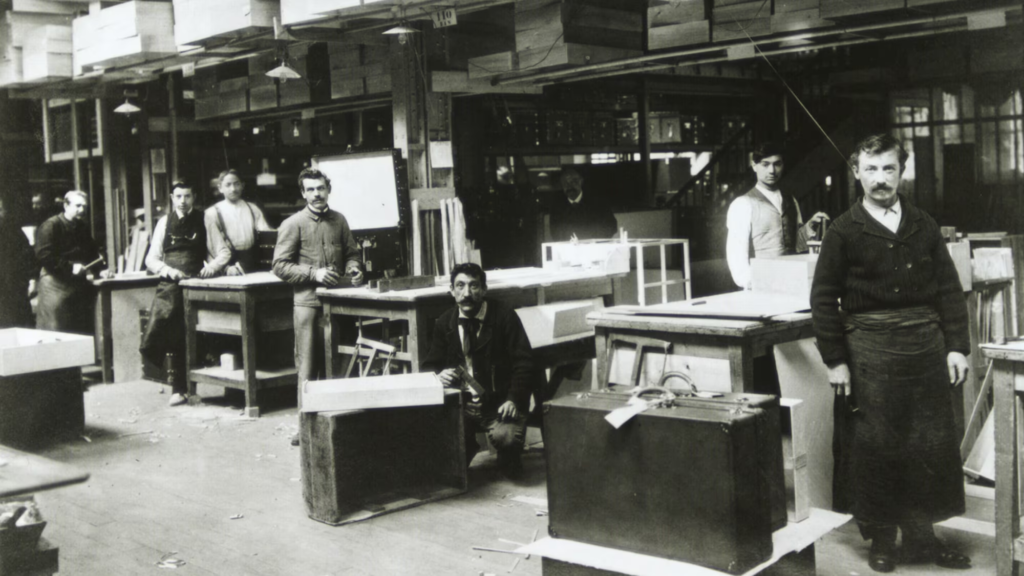Louis Vuitton has a rich history that dates back to 1854. At the heart of this legacy is the iconic Louis Vuitton trunk, a masterpiece of design and functionality that has remained a symbol of sophistication for over a century. This article explores the history, evolution, and enduring appeal of the Louis Vuitton trunk, a quintessential representation of the brand’s heritage and craftsmanship.
The Birth of an Icon
The story of the Louis Vuitton trunk began in 1854 when Louis Vuitton, a trunk maker, opened his first workshop in Paris. He honed his skills for 17 years before starting his own company. Vuitton’s innovative approach to luggage design revolutionized the industry. At a time when travel trunks were typically rounded to shed water, Vuitton introduced the first flat-topped trunks, which were stackable and thus more practical for transport. The sign outside the company read: “Securely packs the most fragile objects. Specialising in packing fashions.”

Vuitton’s trunks were revolutionary because of the shape and the material they used. The trunks were rectangular-shaped, unlike the curved-top leather trunk of the time. They were stackable, which makes train travel much easier. The trunks were covered in Vuitton’s signature Trianon canvas, a durable and lightweight material that was also waterproof. This design quickly gained popularity among the elite, setting the stage for Louis Vuitton’s reputation as the premier maker of luxury luggage. In 1886, Vuitton and his son Georges developed a single lock system with two spring buckles. After years of improvement, Georges patented this revolutionary lock system.
Evolution of Design
After Louis Vuitton died, Georges took over the company, building the basis of the current global popularity. However, as the brand became very popular, they started to be bothered by lots of counterfeits and imitations. They even put advertisements on magazines, warning consumers not to be deceived by the fake products. Then, in 1896, Georges introduced the famous Monogram canvas, featuring the iconic LV initials, floral motifs, and quatrefoil patterns. This distinctive design not only enhanced the trunks’ aesthetic appeal but also served as an early form of trademark to combat counterfeiting.
Over the years, Louis Vuitton trunks have evolved to incorporate various materials and designs. From the classic Monogram and Damier canvases to the luxurious Epi leather and contemporary collaborations with artists and designers, each trunk reflects the brand’s commitment to innovation and excellence.
Craftsmanship and Customization
What sets Louis Vuitton trunks apart is the unparalleled craftsmanship that goes into their creation. Each trunk is handcrafted by skilled artisans using traditional techniques passed down through generations. The process involves meticulous attention to detail, from selecting the finest materials to assembling the intricate components.
Louis Vuitton also offers bespoke services, allowing clients to customize their trunks to suit their specific needs and tastes. This includes personalized interiors, unique sizes and shapes, and even hand paintings on the surface. The result is a one-of-a-kind piece that reflects the owner’s personality and lifestyle.
The Trunk as a Cultural Icon
Throughout its history, the Louis Vuitton trunk has transcended its practical purpose to become a cultural icon. It has been featured in films, literature, and art, symbolizing luxury and adventure. Famous explorers, aristocrats, and celebrities have all been associated with Louis Vuitton trunks, enhancing their mystique and allure.
One of the most famous examples is the custom-made trunk created for French stage actress Sarah Bernhardt in the late 19th century. Ahead of her tour in Brazil, Louis Vuitton made no fewer than 200 suitcases to store all her expensive and delicate dresses and accessories. Another example is a bed trunk made for the world explorer Pierre Savorgnan de Brazza. Before each trip, he ordered new pieces and had some of his luggage restored.
Recent Trends
In recent years, Louis Vuitton has continued to celebrate its heritage while embracing contemporary design. The brand has collaborated with artists such as Takashi Murakami and Yayoi Kusama to create limited-edition trunks that blend traditional craftsmanship with modern art.
The iconic trunk has also been reimagined in various forms, including jewellery cases, watch boxes, and even a portable cocktail bar. These modern interpretations pay homage to the original design while showcasing the versatility and timeless appeal of the Louis Vuitton trunk.
View this post on Instagram
The Louis Vuitton trunk is more than just a piece of luggage; it is a symbol of timeless luxury, innovation, and craftsmanship. From its humble beginnings in the 19th century to its status as a cultural icon today, the trunk represents the enduring legacy of Louis Vuitton. It embodies the spirit of travel and adventure, while also reflecting the brand’s commitment to quality and excellence. As Louis Vuitton continues to innovate and evolve, the iconic trunk remains a testament to the brand’s rich history and its unwavering dedication to creating beautiful, functional, and timeless pieces.
























Leave a Reply